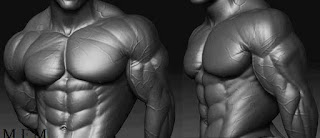Pectoral muscle exercise Developed coated bar Bench
Developed coated bar
Bench
This very popular bodybuilding exercise develops the chest. Coated development is a basic exercise that involves two joints (elbow and shoulder) and allows to work the entire bust, not just the pectorals. It is one of the movements that evaluates the muscular strength of the upper limbs and is used in athletic strength tests.
Targeted muscles
It urges the muscles of the trunk, mainly the large and the small pectoral, the anterior deltoid, the triceps. Other muscles intervene depending on the way of performing the exercise, positioning and maintaining balance such as the latissimus dorsi, the large serratus, the muscle of the arm brachial arm, the buttocks, the lumbar and abdominal.
Execution of the exercise
Extended starting position on the bench press. The bar placed on the supports is at eye level. Place the hands on the bar, in pronation, spread apart a distance slightly greater than the width of the shoulders. Bend the legs and fold them down to have the lumbar glued to the bench and avoid bending. You can also put your feet on the edge of the bench or flat on the ground for more balance but do not lift the buttocks by pushing.
Unhook the bar from the brackets and immobilize it with arms outstretched. It is then at the top of the pectorals. Lower the load slowly, controlling it, until the pectorals (nipples). Return to initial position.
Note that the movement of the bench press is not strictly vertical. At the end, rest the bar gently on the supports with the help of the partner.
Breathing
Breathe in as you lower the bar and exhale when you return to the starting position.
It is not recommended to block breathing during the difficult phase. Nevertheless this maneuver makes it possible to stabilize the bust and gives a solid base for the muscles of the shoulders and the chest. If you use heavy loads, exhale after passing the delicate point.
Safety instructions
If you work with heavy loads, you need a partner to assist you because you can be stuck under the bar and seriously injure yourself. If nobody can assure you, work with the dumbbells.
There are several possibilities for the placement of the legs. Here are three:
Bend the knees and lower the legs to have the lumbar glued to the bench and not arch the lower back. This position can cause initial equilibrium problems.
Bend your legs and put your feet on the edge of the bench. This makes it possible to limit the camber of the lower back and to have a correct balance.
Lay the feet flat on the floor for more balance. It will then be necessary to watch the camber of the lower back, contract the abdominals and not take off the buttocks. If you take off the buttocks during the concentric phase, you accentuate the camber of the lumbar region and create significant pressures in the vertebrae and intervertebral discs. This can lead to pinching of discs and herniated discs.
To take the bar, two possibilities:
If you break the wrist, the bar is in the palm of your hand. The thumb must be under the bar so that it rests on the axis of the forearm.
If you do not break your wrist, your thumb should not be under the bar to prevent it from slipping or slipping out of your hands, and to minimize tension at the wrist joint (wrist compression).
Lower the bar slowly without causing it to bounce dangerously on the rib cage.
Do not change position while performing the exercise. One often sees practitioners twisting in half to finish their series.
variants
It is possible to carry out the exercise with the elbows along the body rather than displaced. This will bring the work to the front of the shoulders.
The closer the hands are, the more the triceps will be solicited. Note that the grip tight elbows separated from the bust solicits more the sternal part (the inside of the pectorals).
You can bring the bar towards the neck, this will solicit more the upper part of the pectoral (clavicular).
You can do the bench press using dumbbells or a bar, on flat bench, inclined or declined. There are also machines in the weight rooms where one is seated or standing like the Smith machine. They can be an alternative to developed lying at the free bar.





















No comments